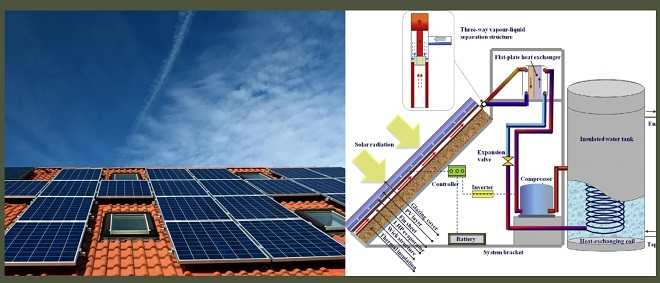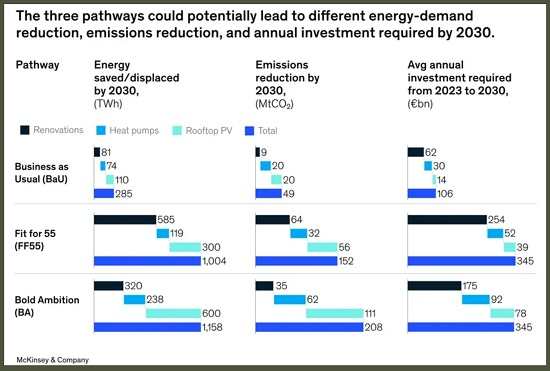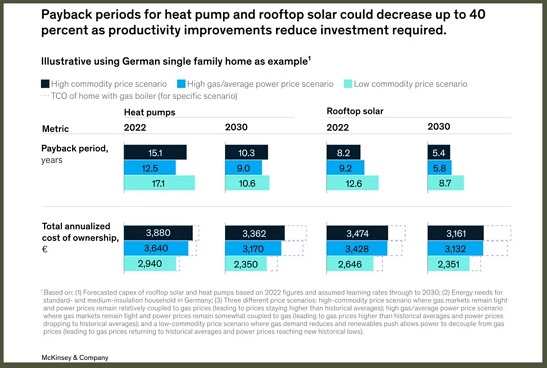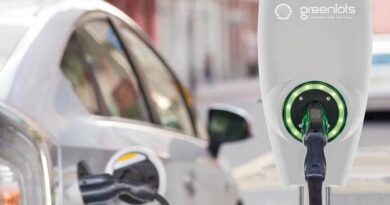The profitability of solar energy and heat pumps increases
The profitability of solar energy and heat pumps increases
A recent report by McKinsey & Company has found that the amount of time it takes for investments in heat pumps and solar power systems for buildings to pay off could be significantly reduced by 2030.

In other words, the cost of these investments could be recovered faster than they are currently. That could be due to a combination of factors such as decreasing costs, improvements in technology, and government incentives. As a result, investing in renewable energy solutions like heat pumps and solar power could become even more financially attractive shortly.
The energy efficiency of buildings has become a topic of growing importance in recent years due to both its environmental and economic benefits. By improving the energy efficiency of buildings, we can reduce the amount of energy that is wasted and help to protect the environment.
In addition, making buildings more energy-efficient can also lead to significant cost savings for homeowners and businesses. Two solutions that are gaining popularity are solar energy and heat pumps, which can help to improve the energy efficiency of buildings and reduce the cost of energy.
Solar energy harnesses the power of the sun to generate electricity, while heat pumps use electricity to extract heat from the air or ground, and then use that heat to warm up a building. By implementing these solutions, we can make our buildings more sustainable and cost-effective while also contributing to the fight against climate change.
McKinsey & Company, a global management consultancy, has released a new report suggesting the amount of time it takes for investments in heat pumps and solar power to pay off could be reduced by several years by 2030.
That means that the cost of investing in these technologies could be recovered faster, making them more financially attractive to potential buyers. The report states that the increasing scale of these industries in the European Union (EU) will help to reduce production and installation costs, which will contribute to the increased attractiveness of these investments.
As a result, the adoption of renewable energy solutions like heat pumps and solar power is expected to become more widespread, contributing to the reduction of greenhouse gas emissions and the fight against climate change.
Three potential price scenarios
The report mentioned considers three different price scenarios using a German single-family home as an example. These scenarios are based on different prices for commodities such as oil and gas, which affect the cost of energy.
The first scenario, “High Commodity Price,” assumes that prices for these commodities will remain high, leading to increased energy costs.

The second scenario, “High Gas Price but Average Energy Price,” assumes that gas prices will be high while other energy prices remain average.
The third scenario, “Low Commodity Prices,” assumes that gasoline prices will return to historical averages and energy prices will hit new lows.
By analyzing these different scenarios, the report can assess the financial implications of investing in renewable energy solutions like solar power and heat pumps and help individuals and businesses make informed decisions about the potential benefits and risks of these investments.
In the “Low Commodity Prices” scenario analyzed in the report, heat pumps and solar power have the longest payback periods among the renewable energy solutions studied.
However, the report also found that these technologies can experience significant reductions in payback periods between 2022 and 2030. For instance, the payback period for heat pumps could decrease by 38%, from 17.1 years in 2022 to 10.6 years in 2030, while the payback period for solar power could fall by 31%, from 12.6 years in 2022 to 8.7 years in 2030. That means that the initial investment cost of these technologies could be recovered much faster by 2030, making them more financially attractive to potential buyers.
The report’s findings suggest that the adoption of renewable energy solutions like heat pumps and solar power could become more widespread in the coming years, contributing to a cleaner and more sustainable future.
In the “Average Energy Price” scenario analyzed in the report, heat pumps and solar power also experience significant reductions in payback periods between 2022 and 2030.
The payback period for heat pumps could be reduced from 12.5 years in 2022 to nine years in 2030, while the payback period for solar power could fall from 9.2 years in 2022 to 5.8 years in 2030. That means that the investment cost for these technologies could be recovered faster by 2030, making them more financially attractive to potential buyers.
The report’s findings suggest that the adoption of renewable energy solutions like heat pumps and solar power could become even more widespread in the coming years, leading to a more sustainable and cost-effective energy system.
In the most favorable scenario, the payback period for solar energy could drop by 34% from 8.2 years in 2022 to 5.4 years in 2030. That means that the investment cost of installing solar panels can be covered by the energy savings generated in 5.4 years, which is a shorter period than before.
Similarly, the payback period for heat pumps could also drop from 15.1 years in 2022 to 10.3 years in 2030, which is a 32% decrease. That means that the investment cost of installing heat pumps can be covered by the energy savings generated in 10.3 years, which is also a shorter period than before.
Overall, this means that solar energy and heat pumps are becoming more cost-effective and efficient, making them more attractive options for homeowners and businesses looking to reduce their energy costs and environmental impact.
Three initiatives to improve energy efficiency
Three initiatives that can help improve the energy efficiency of buildings in the European Union.
The first initiative is to increase the installation of rooftop solar panels. Solar panels can generate electricity from sunlight, which can be used to power homes and buildings.
The second initiative is to increase the installation of heat pumps. Heat pumps are devices that can extract heat from the air or ground and transfer it to a building to provide heating and hot water. Heat pumps are more energy-efficient than traditional heating systems, which can reduce energy consumption and lower energy bills.
The third initiative is to improve the insulation of buildings. Insulation can help to prevent heat loss from buildings, which means that less energy is needed to maintain a comfortable temperature inside.
The European Union’s goal is to increase the use of renewable energy in buildings to reduce carbon emissions and combat climate change. Two specific targets: Fit-for-55 and Repower EU.
An annual deployment of solar panels in buildings of around 33 GW (gigawatts) will be required to achieve these targets. That means that 33 GW worth of solar panels will need to be installed each year to meet the targets.
That goal to the record rate of 22 GW in 2022, and the average rate of 10 GW for the last four years, indicating that a significant increase in solar panel installations will be needed to meet the targets.

The deployment of heat pumps will need to continue to grow at a rate of 12.5% per year until 2030 to reach the RepowerEU target of 54 million heat pumps by 2030. That means more heat pumps will need to be installed each year to meet the target.
These drivers are necessary to catalyze the changes needed to increase the use of renewable energy in buildings and reduce carbon emissions. By focusing on upskilling the workforce, establishing appropriate incentives, attracting private capital, investing in network infrastructure, and creating circular and net supply chains, it is possible to achieve the goals of a more sustainable and renewable energy future.
Solar energy, heat pumps, and insulation
Implementing heat pumps and solar energy in homes and buildings can bring several benefits.
One of the benefits is that it can reduce energy costs in the long term. By using renewable energy sources like solar energy and heat pumps, homes and buildings can reduce their reliance on traditional energy sources like fossil fuels, which can be expensive. That can lead to lower energy bills in the long run.
Another benefit is that it can help to reduce the carbon footprint of homes and buildings across Europe. Traditional energy sources like fossil fuels are significant contributors to greenhouse gas emissions, which are a major cause of climate change.
By using renewable energy sources like solar energy and heat pumps, homes and buildings can reduce their reliance on fossil fuels and lower their carbon footprint.
Implementing heat pumps and solar energy in homes and buildings can bring several benefits, including lower energy costs, reduced carbon footprint, and improved energy security.
The McKinsey & Company report also highlights the importance of improving building insulation to improve energy efficiency.
Proper insulation is important because it helps to keep the temperature inside homes and buildings at a comfortable level, without using too much energy. By using less energy, we can save money on our energy bills and reduce the number of greenhouse gases that are released into the atmosphere.
If a building is not well-insulated, it can lose heat in the winter and gain heat in the summer, which means that heating and cooling systems need to work harder to maintain a comfortable temperature. That can result in higher energy bills and more greenhouse gas emissions.
On the other hand, if a building is well-insulated, it can retain heat in the winter and stay cooler in the summer, which means that heating and cooling systems don’t need to work as hard to maintain a comfortable temperature. That can result in lower energy bills and fewer greenhouse gas emissions.
In addition, better insulation can reduce the need for larger, more expensive heating and cooling systems. That can save even more money and further reduce emissions, as larger systems tend to use more energy and produce more greenhouse gases.
Overall, proper insulation is an important step in reducing energy costs and greenhouse gas emissions and can lead to a more comfortable and sustainable living or working environment.
To reduce carbon emissions and improve energy security, it is important to invest in infrastructure and supply chains for renewable energy systems. These systems, such as solar or wind power, can help generate clean energy without relying on fossil fuels.
However, to fully realize the benefits of renewable energy systems, they need to be implemented properly and supported by adequate infrastructure and supply chains.
For example- if we want to increase the use of solar power, we need to invest in building solar panels and developing the technology to store and distribute the energy that is generated.
We can help achieve the EU’s decarbonization targets, which aim to reduce carbon emissions and combat climate change. At the same time, investing in renewable energy infrastructure can improve energy security by reducing reliance on foreign oil and gas.
Overall, with the proper investment and implementation, renewable energy systems can be an effective way to reduce carbon emissions and improve energy security, while also helping to build a more sustainable future.
Related Post



